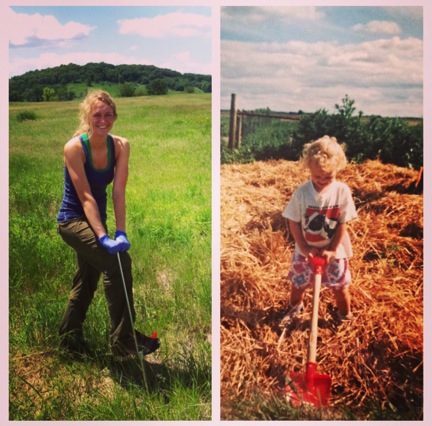I got it from my mama…
Add Summary

June 14, 2016
Anna Herzberger is an MSU Center for Systems Integration and Sustainability doctoral student doing research in the Heilongjiang Province in northeastern China. She hails from the farmlands of Virginia, Ill.
It’s May. I am sitting in my studio apartment, looking at old take-out Chinese boxes with disgust and attempting to pack for my field season in China. In only one bag. How many pairs of socks should I pack? How much instant coffee does a summer of data collection in Asia require? Can I really carry 50 pounds, everyday, on my back?
My phone rings…
ME: “Ni Hao”
MOM: “Why are you learning Mandarin again?” She asks suspiciously.
ME: Eyeing the take-out boxes, “I really like Kung Pao chicken,” I offer.
MOM: “No really Anna, I thought you went to grad school to study agriculture? Why are you learning Mandarin and why are you going to China again?”
This was the moment academia has been preparing for, the iconic elevator speech. We academics are well aware that are research isn’t always intuitive or interesting to the public, but also appreciate how important it is for us to share our research in a meaningful way. What I plan to do in China I find very important, now to convince my mom (and everyone reading this) it was important.
I begin, “I am studying agriculture … just on the macro scale.” No, no, no, you can do better than that Anna, I think.
I start again, “Think of our farm, Mom. We have a small fourth-generation family farm in rural Illinois that specialized in soy and corn production. Did you know Illinois is the #1 state for soybean production (suck it, Iowa) and we export half of our production overseas. Also, China imports 60 percent of all the soybeans produced in the world, more than 33 million tons from the U.S. alone”.
specialized in soy and corn production. Did you know Illinois is the #1 state for soybean production (suck it, Iowa) and we export half of our production overseas. Also, China imports 60 percent of all the soybeans produced in the world, more than 33 million tons from the U.S. alone”.
My voice rises in excitement…. But I can sense her beginning to fade…
One last try, “Ok, Mom, imagine this… a single soybean from our farm rolls into the drive way, somehow it manages not to get crushed by the tractors and semis that are busily preparing for harvest. That single soybean then magically makes it to town, where it will have more opportunities. At the grain elevator, that soybean and others avoid being crushed and turned into animal feeds, edible oils or cosmetics in the United States and board a train to the west coast, then a boat to China where it eventually is crushed for protein in animal feed.”
MOM: “Ok so you are studying the journey of a soybean from America to China?”, she asks, interest beginning to perk.
ME: “Not exactly. When the soybean from our farmed arrived in China the buyers liked it better because it was cheaper than the soybeans grown in China. They bought our soybean instead and that caused the Chinese soybean to decrease in value. All the sudden, Chinese farmers who have been cultivating soybeans all their lives couldn’t make as much money.”
MOM: “So what happened to the Chinese farmers?”
ME: “EXACTLY!” I’m really excited now. “The Chinese farmers had to start growing corn or rice instead.”
MOM: “But your dad says he grows corn and soybeans together to protect the soy.”
ME: “Yes! Yes! Yes! That’s WHY I’m going to China! I am interested in first, how the soybeans from our farm are affecting what Chinese farmers plant. Second, how are these changes affecting the soil”.
MOM: “Well that’s pretty cool but I still don’t understand why you can’t study that in the U.S. We grow corn here you know.”
ME: “Precisely. We grow corn and soy here in a rotation to help buffer the soil from acidification, pest outbreaks and pathogenic mic



 Print
Print Email
Email





